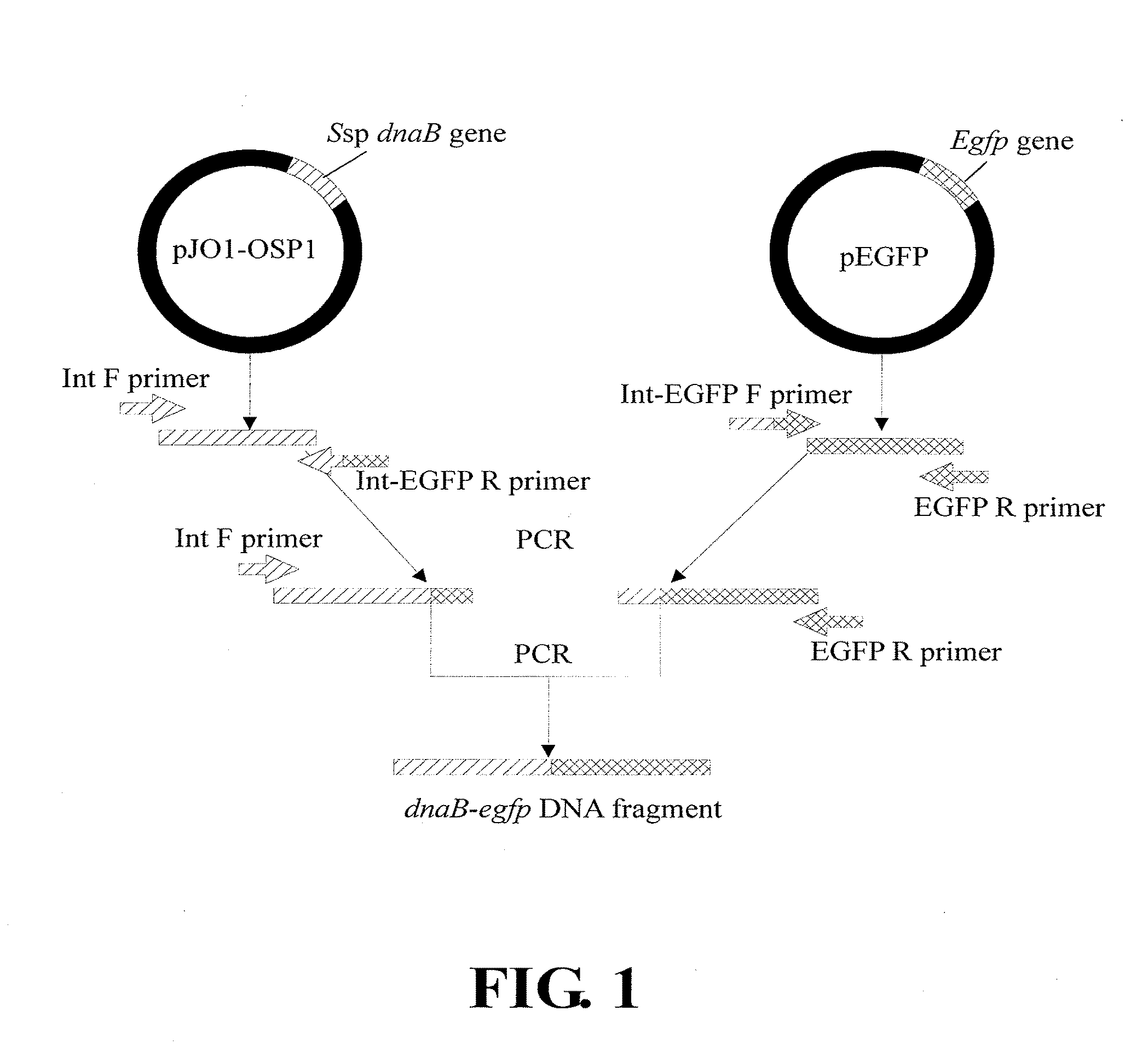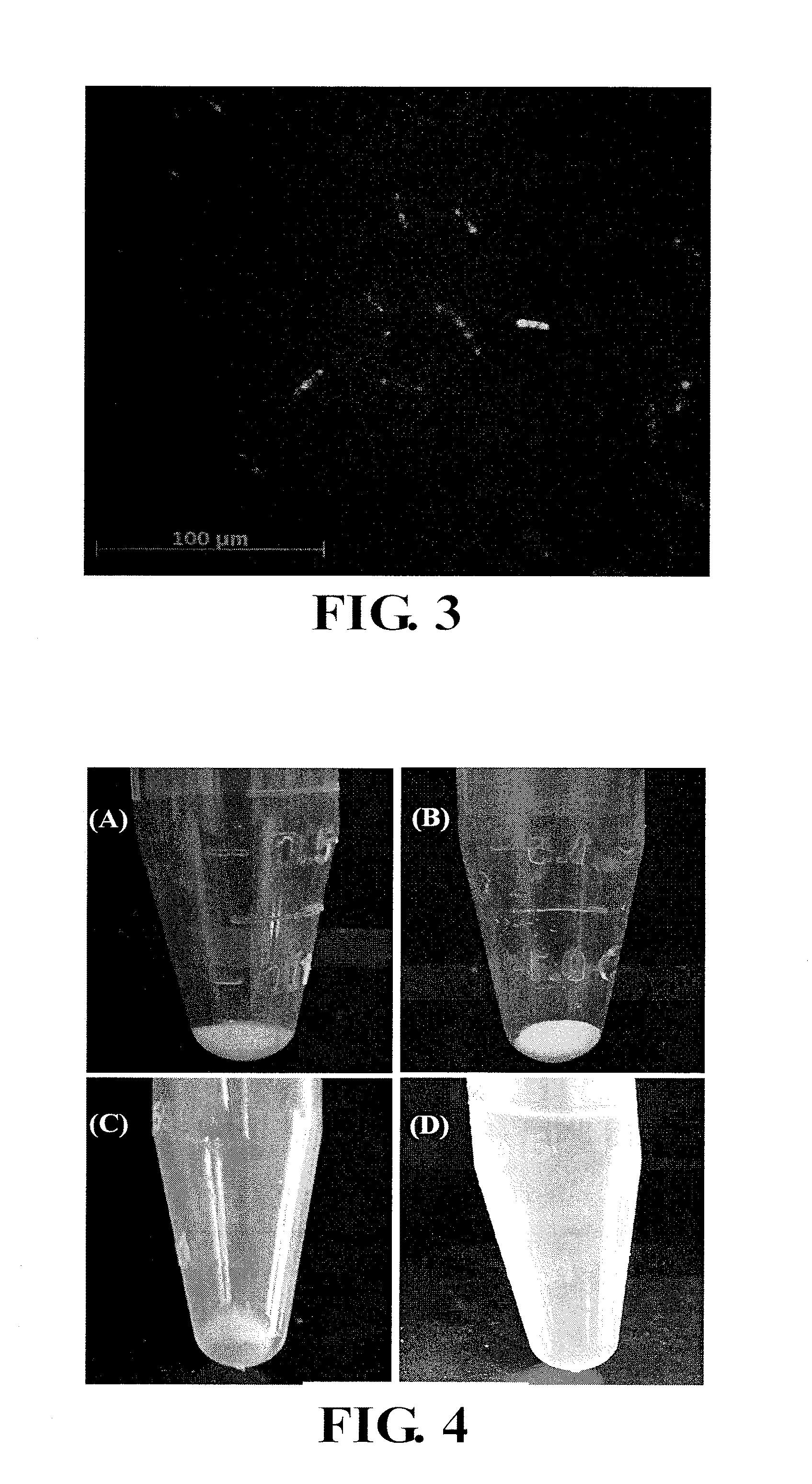Expression Cassette, Recombinant Host Cell and Process for Producing a Target Protein
a technology of host cell and expression cassette, which is applied in the field of expression cassette, a recombinant host cell and a target protein production process, can solve the problems of increasing the difficulty and complexity of protein isolation and purification, affecting the quality of protein purification,
- Summary
- Abstract
- Description
- Claims
- Application Information
AI Technical Summary
Problems solved by technology
Method used
Image
Examples
example 1
Construction of Recombinant Vector pINPNC-INT-EGFP
[0102]A. Preparation of a dnaB-egfp DNA Fragment Containing a Ssp dnaB Gene Fused with an egfp Gene
[0103]The dnaB-egfp DNA fragment, which contains in sequence along a transcription direction an intact Ssp dnaB gene fused with an intact egfp gene, was obtained according to the construction scheme shown in FIG. 1 and the procedures described below.
[0104]Based on the nucleotide sequence of the Ssp dnaB gene located in the plasmid pJO1-OSP1, i.e., nucleotide residues 4578 to 5057 in SEQ ID NO:1, and the nucleotide sequence of the egfp gene located in the plasmid pEGFP, the four primers as shown in the following Table 1 were designed:
TABLE 1Primers used in the production of the dnaB-egfp DNA fragment viaPCR reactionPrimerNucleotide sequence (5′→3′)Int FEcoRIccggaattcatggtgcgcgagtccg (SEQ ID NO: 3)Int-EGFP Rcgcccttgctcaccatgttgtgtacaatgatgtc (SEQ ID NO: 4)Int-EGFP Fgacatcattgtacacaacatggtgagcaagggcg (SEQ ID NO: 5)EGFP RXhoIccgctcgagttactt...
example 2
Production of Enhanced Green Fluorescent Protein (EGFP) from Fusion Protein INPNC-INT-EGFP Expressed by E. coli DH1(DE3) / pINPNC-INT-EGFP
Experimental Procedures:
[0112]A. Production of Fusion Protein INPNC-INT-EGFP in Cells of E. coli DH1(DE3) / pINPNC-INT-EGFP by isopropyl-β-D-thiogalactopyranoside (IPTG) Induction
[0113]The cells of E. coli transformant DH1(DE3) / pINPNC-INT-EGFP as obtained in Example 1 were inoculated into 40 mL of the LB broth containing 50 μg / mL kanamycin and cultivated at 37° C. with shaking (150 rpm). After reaching a cell density of about 1 (OD600), the bacterial culture was added with IPTG to a final concentration of 1 mM, and then cultivated at 18° C. (to prevent protein aggregation) with shaking (150 rpm) for further 24 hrs, so as to induce the bacterial cells to express the fusion protein INPNC-INT-EGFP. Bacterial culture without IPTG induction was used as a control.
[0114]Thereafter, a few drops of the bacterial culture with or without IPTG induction was added...
example 3
The Influence of pH and Temperature on the DnaB Intein Self-Cleavage
A. The Influence of pH on the DnaB Intein Self-Cleavage
[0133]The cells of E. coli transformant DH1(DE3) / pINPNC-INT-EGFP as obtained in Example 1 were inoculated into 40 mL of the LB broth containing 50 μg / mL kanamycin and cultivated at 37° C. with shaking (150 rpm). After reaching a cell density of about 1 (OD600), the bacterial culture was added with IPTG to a final concentration of 1 mM, and then cultivated at 18° C. (to prevent protein aggregation) with shaking (150 rpm) for further 24 hrs, so as to induce the bacterial cells to express the fusion protein INPNC-INT-EGFP. The resultant bacterial culture was then centrifuged at 8000 rpm for 10 min. The pellet thus collected was washed twice with the washing buffer (pH 8.5), re-suspended in 10 mL of the reaction buffer having a designated pH (pH 6, 7, 8, 9 or 10), and incubated at 37° C. with shaking (50 rpm), so as to induce DnaB intein self-cleavage. At a designat...
PUM
| Property | Measurement | Unit |
|---|---|---|
| Temperature | aaaaa | aaaaa |
| Temperature | aaaaa | aaaaa |
| Temperature | aaaaa | aaaaa |
Abstract
Description
Claims
Application Information
 Login to View More
Login to View More - R&D
- Intellectual Property
- Life Sciences
- Materials
- Tech Scout
- Unparalleled Data Quality
- Higher Quality Content
- 60% Fewer Hallucinations
Browse by: Latest US Patents, China's latest patents, Technical Efficacy Thesaurus, Application Domain, Technology Topic, Popular Technical Reports.
© 2025 PatSnap. All rights reserved.Legal|Privacy policy|Modern Slavery Act Transparency Statement|Sitemap|About US| Contact US: help@patsnap.com



